An Unusual Case of Signet Ring Cell Cholangiocarcinoma- Case Report and a Review of Literature_Juniper Publisher
ADVANCED RESEARCH IN GASTROENTEROLOGY & HEPATOLOGY JUNIPER PUBLISHERS
Authored by Shechter Yonat
Cholangiocarcinoma is an uncommon adenocarcinoma with poor prognosis. Signet ring cell cholangiocarcinoma is an extremely rare disease, with only 11 cases reported to date. However, its incidence is increasing. Interestingly, there is increased incidence of other SRC tumors (colon, gastric, etc.) as well. Most cases have described a localized mass of signet ring cells, most commonly in the common bile duct. In our report, a 69-year-old Caucasian man presented with jaundice and abdominal pain of three days. The patient underwent a CT scan, ERCP, and EUS as part of his initial workup. Biopsies were obtained during EUS from the CBD disclosing signet ring cholangiocarcinoma. ERCP showed a diffusely infiltrative tumor of both left and right hepatic ducts. This appears to be the first description of diffuse type signet ring cell cholangiocarcinoma. Unfortunately, the patient experienced rapid clinical deterioration which precluded treatment. Survival was extremely short-the patient passed away three weeks after initial appearance of symptoms. As the incidence of SRC's in general, as well as the incidence of SRC cholangiocarcinoma appear to be on the rise, more cases are likely to be encountered. If our observation of the extremely virulent presentation of diffuse-type SRC cholangiocarcinoma is confirmed, perhaps palliative care only should be considered in these patients at the onset.
Keywords: Cholangiocarcinoma; Signet ring cell; ERCP; EUS
Abbreviations: CC: Cholangiocarcinoma; SRC: Signet Ring Cell; CBD: Common Bile Duct, ERCP: Endoscopic Retrograde Cholangiopancreatography, EUS: Endoscopic Ultrasound, CT: Computed Tomography
Introduction
Cholangiocarcinoma (CC) is a mucin producing adenocarcinoma that arises from bile duct epithelium [1]. It is an uncommon adenocarcinoma with poor prognosis (5-year survival is less than 5%) and most patients initially present with advanced disease [2]. Cholangiocarcinomas are grouped by their anatomic site of origin in descending order: Hilar (65%), Distal (30%) and Intrahepatic. Diagnosis is made by biopsy, usually obtained via endoscopic retrograde cholangiopancreatography (ERCP) [1].
Signet-ring-cell (SRC) Cholangiocarcinoma is an extremely rare variant, with only 11 cases reported to date [3-13]. All cases describe a localized mass, usually in the extrahepatic biliary tract. To the best of our knowledge, this is the first reported case of diffuse SRC cholangiocarcinoma, with no distinct mass on imaging studies. Furthermore, the patient we describe had a fulminant course of disease, with only 3 weeks separating initial presentation to patient death.
Case Report
The patient is a 69-year-old male with no significant past medical history of Ashkenazi Jewish descent. The patient presented with new onset Jaundice and a three-day history of abdominal pain. He further denied any previous gastrointestinal illness. Blood chemistry showed: total Bilirubin 4.8mg/dl, AST 305IU/L (N<40), ALT 374IU/L (N<70), ALP 571IU/L (N<150), GGT 1925IU/L(N<73) and CA 125 was 45.9U/ml (N<35). serum electrolytes, CA 19-9, creatinine and amylase were found to be within normal limits. Abdominal Computed Tomography (CT) showed mild dilatation of intrahepatic bile ducts, predominantly in the right lobe, and a dilated gallbladder containing gallstones. No other abnormality was found (Figure 1). Endoscopic ultrasound (EUS) showed strictures of the left hepatic duct, proximal bifurcation of common hepatic duct, and common bile duct (the right hepatic duct could not be visualized). Needle biopsies were taken from the proximal common bile duct (CBD) and from an enlarged lymph node in the porta hepatis. The biopsies showed poorly differentiated signet ring adenocarcinoma. The tumor was at least stage IIIB (T1-3, N=1, M=0) [14]. An ERCP was also performed, showing multiple PSC-like strictures and beadings in the intrahepatic bile ducts. Attempted plastic stent insertion to the left system failed twice, and a metallic uncovered stent was inserted into distal right system. Colonoscopy was normal and didn't show any other site of primary malignancy explaining the signet ring cell carcinoma.
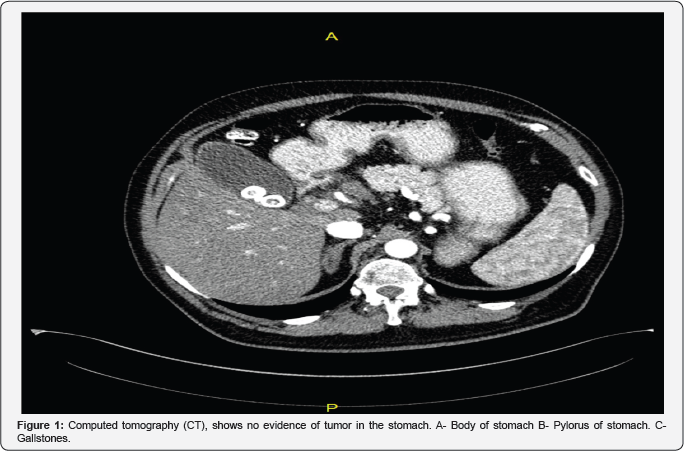
Unfortunately, once the diagnosis was made the patient experienced rapid clinical deterioration-bilirubin levels increased to 21.3mg/dl and ALP levels rose to 1579, despite partial drainage. Several days after clinical deterioration, and only three weeks after initial presentation, the patient expired.
Discussion
Signet Ring Cells (SRCs) are characterized by a thin intracellular circle with a thicker nuclear projection to one side, thereby imitating a signet ring. Their shape is created by loss of function of the tumor suppressor gene CHD1, leading to the loss of the cell adhesion protein E-cadherin. Thus, these cells cannot form normal glands, mucin cannot be secreted and accumulates in large vacuoles that expand the cytoplasm and push the nucleus to the periphery, creating a signet-ring cell morphology [15]. SRC tend to infiltrate the mucosal wall diffusely, thickening it [15]. It presents mainly in the stomach but may also present in other organs - colon, prostate, bladder, and others [16]. Regardless of its location, SRC carcinoma cARGHies a poorer prognosis when compared to non-SRC carcinomas because of a higher prevalence of peritoneal carcinomatosis and lymph node invasion at initial diagnosis and lower R0 resection rate due to its infiltrative nature [17]. This rule also applies to SRC biliary carcinoma (Table 1).
Despite the overall decrease in the incidence of gastric cancer, the incidence of SRC gastric carcinoma is increasing, especially in western countries [16]. The incidence of signet ring cell colorectal carcinoma is increasing as well [18]. SRC carcinoma of the biliary tract, first described in 1999, is extremely rare with only eleven cases described so far. Nevertheless, a clear trend of increasing incidence and/or increasing awareness can be seen: from 0.14 cases per year between 1999-2006, to one case a year between 2007-2014, to two cases per year in 2015-2016. The main demographic and clinical data are summarized in table 1. Asian ethnicity is predominant with an equal distribution of males and females. All patients initially presented with jaundice.
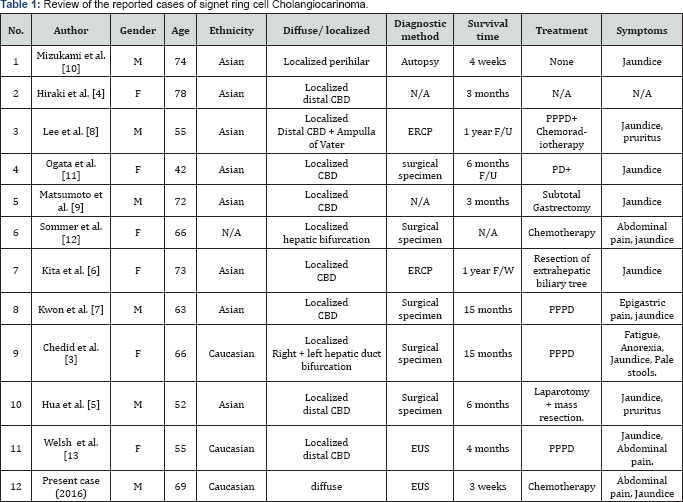
PPPD= Pylorus Preserving Pancreatoduodectomy, PD= Pancreatoduodectomy, N/A= Not Available
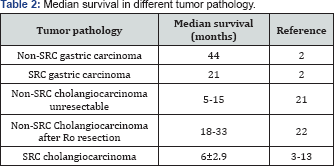
This case is unique for several reasons. First, all cases of SRC cholangiocarcinoma reported so far described a tumor mass: In 7 cases the mass was localized to the CBD, in S other cases the mass was in the bifurcation of the hepatic ducts and one unknown origin. In contrast, SRC in other organs - stomach, colon, breast, etc. tends to spread diffusely in the organ, not creating distinct masses. Likewise, this patient demonstrated no mass on CT imaging. ERCP raised the suspicion of malignant involvement of the mid CBD, infiltrating diffusely into both left and right hepatic ducts. This was later histologically confirmed. Additionally, the rapid clinical deterioration experienced in this patient was uniquely virulen-three-week survival when compared to a median survival of 6 months (Table 2). Finally, most other reports were of patients with Asian ethnicity, while our case is the first case of Caucasian male, and the second case of Caucasian ethnicity overall
The diagnosis in this case was made by EUS guided FNA biopsy. Both ERCP and EUS sampling may provide tissue for diagnosis in suspected malignant biliary obstruction. However, the literature shows that EUS is superior to ERCP as a diagnostic method (66-90% sensitivity, 90-100% specificity vs 50% sensitivity, 53% specificity respectively) [19]. EUS is particularly useful in patients without a definite mass lesion seen on cross sectional imaging [20] (Figure 2-4).
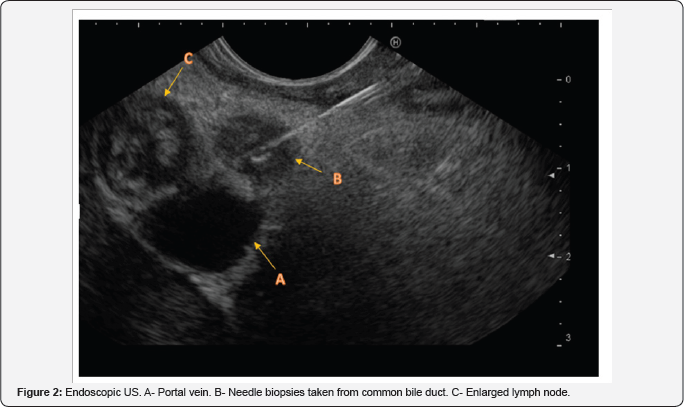
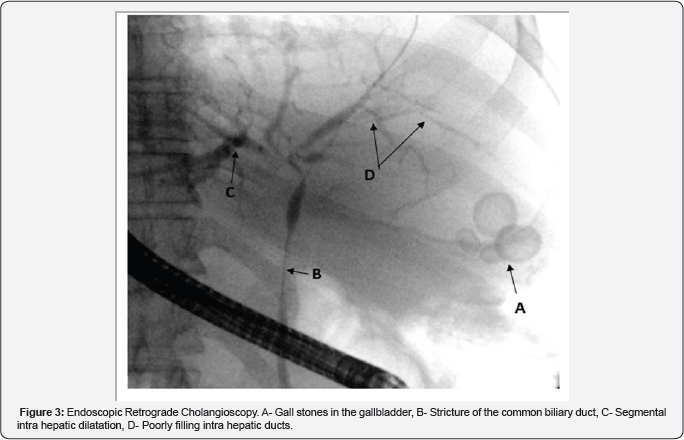
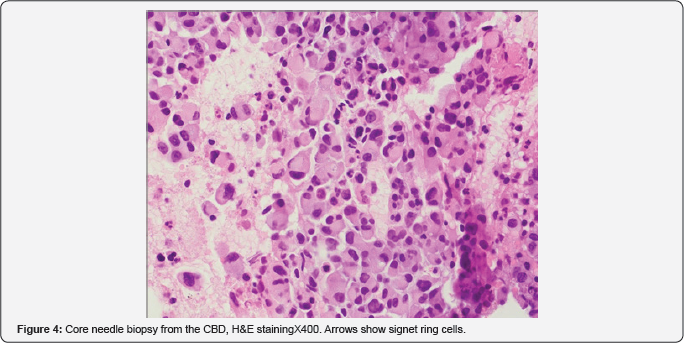
This appears to be the first description of diffuse-type SRC cholangiocarcinoma. While limited in scope, it appears to suggest an extremely aggressive pathological sub-type of cholangiocarcinoma, leading to poor clinical outcomes and a short survival time. As the incidence of SRC's in general as well as the incidence of SRC cholangiocarcinoma seem to be on the rise, more cases will be encountered. If our observation is confirmed, then perhaps palliative care only should be undertaken in patient with biopsy confirmed diffuse-type SRC cholangiocarcinoma..
For more articles in Advanced Research in Gastroenterology & Hepatology please click on https://juniperpublishers.com/argh/index.php




Comments
Post a Comment